Making the Business Case for Traffic Incident Management
Technical Presentation
Printable version [PDF 2.2 MB]
You may need the Adobe® Reader® to view the PDFs on this page.

Photo sources (clockwise from upper left: Arizona Department of Transportation, Virginia Department of Transportation, Grady Carrick.
slide 1
Making the Business Case for Traffic Incident Management
Technical Presentation

Sources (clockwise from upper left: Arizona Department of Transportation,
Virginia Department of Transportation, Grady Carrick.

slide notes
This presentation provides an overview of the technical aspects of the FHWA report titled, "Making the Business Case for Traffic Incident Management."
slide 2
Overview of Presentation
- What is a business case?
- Why develop a business case for traffic incident management (TIM)?
- Four-phase process to develop a TIM business case
- Key activities in each phase
- Additional resources
slide notes
This presentation is designed to help familiarize you with a business case for TIM as a product, a process, and as a strategy that links investments with program results and, ultimately, with the strategic outcomes of the broader organization.
Each of the four phases of the TIM business case development process includes essential elements and activities to be developed or undertaken. At the end of this presentation, you will have a clear understanding of each phase of the process, as well as additional resources that are available to help throughout the process.
slide 3
What is a Business Case?
A well-reasoned argument designed to convince decision-makers of the benefits of an investment while educating them of the associated changes, costs, and risks
slide notes
A compelling business case for TIM will:
- Demonstrate the benefits of the TIM program
- Address the program's business objectives
- Offer different actions or decisions that would achieve the business objectives
- Explain the value and risks of funding versus not funding
- Provide estimated costs of a range of TIM options
slide 4
Business Case Product vs. Process
A business case is both a product and a process
- The product articulates and demonstrates the business case through writing, numbers, analyses, graphs, charts, embedded videos, and images
- The process helps to formalize and institutionalize the proposed initiative
slide notes
The business case product:
- Articulates the business need, proposed investment, and value generated by making the investment.
- Informs key stakeholders in an effort to gain their support.
The business case development process is as important as the business case product. The process:
- Directs focus on lifecycle processes with phases executed both sequentially and iteratively.
- Prepares a program for success and smart growth.
slide 5
The TIM business case products begin with the business case report and should include other communications media, such as briefings or videos, to target key stakeholders
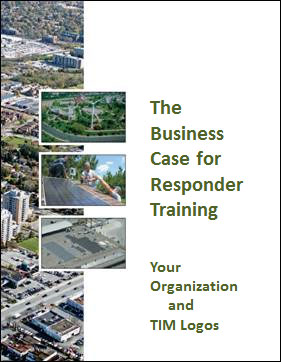
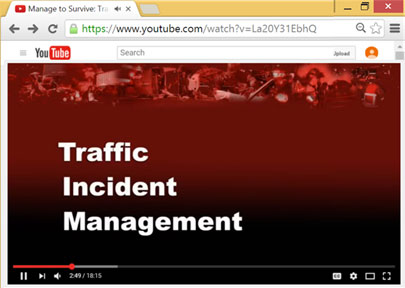
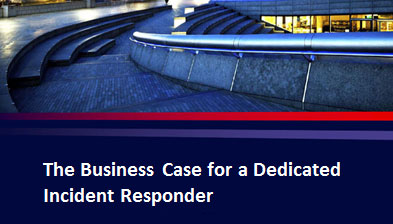
slide notes
While the traditional business case product is a report, a compelling business case may include other communications media, such as targeted briefings, fact sheets, testimony, an informational video, or other communications products, to target key stakeholders. Where available, programs can make use of the materials and documents already produced.
"There is no magic formula when it comes to the size of a business case report or product. The size is irrelevant. What is relevant is that the business case provides all the necessary information to make the job of the decision-maker possible. Brevity is always a virtue." (I. Bogorad – 6 essential elements for a winning business case)
slide 6
The TIM business case development process

slide notes
While the business case product is what ultimately gets delivered or presented, it should not be viewed as the final step. As previously stated, the TIM business case development process is as important as the product itself, helping to formalize and institutionalize the proposed initiative and setting it up for success and smart growth.
The TIM business case development process is a lifecycle process with phases and activities typically, but not always, implemented sequentially. The four phases – shown in this graphic – include:
- Develop vision
- Evaluate and select
- Formalize
- Prepare for implementation
slide 7
Why Develop a Business Case for TIM?
- To establish, maintain, and grow a TIM program, the value of TIM must be accurately estimated and effectively communicated
- To transform a TIM program or project from a stand-alone effort to a sustaining core function of an agency
slide notes
Agencies know intuitively that there is a profound value in TIM programs; however, demonstrating and communicating this value, both internally to executive management and externally to decision-makers, can be challenging:
- The TIM business case process helps to establish the valuation.
- The business case products help to communicate this value.
In addition, a commitment to the business case development process – conducting the activities and repeating the phases – will help to transform a TIM program or project from a stand-alone effort to a sustaining core function of an agency.
slide 8
Scoping and Living the Business Case
- Scoping the business case means:
- Recognizing that the evaluation should align with TIM program costs, as well as the data available
- Understanding the timeline for investment decision-making
- Identifying what business case products will be needed
- Living the business case means:
- Developing, adhering to, and updating the TIM program plan
- Establishing, documenting, and following processes with an eye to the future right-sizing of the program
slide notes
A development of a business case is not a one-size-fits-all endeavor, nor should it be looked at as "once and done."
The level of resources, time, and expertise to develop a business case will be a function of the size of the program and the proposed investment, the data available, and the time-frame within which a decision will be made.
In addition, demonstration and communication of the continued value from the initial investment will ensure that the TIM program remains viable and that future growth opportunities are met with support.
slide 9
DEVELOP VISION
Key elements of the vision:
- Organizational overview
- Problem or need statement
- Drivers for change
- Proposed solution and options
- Desired outcomes
- Strategic fit of the project in the agency
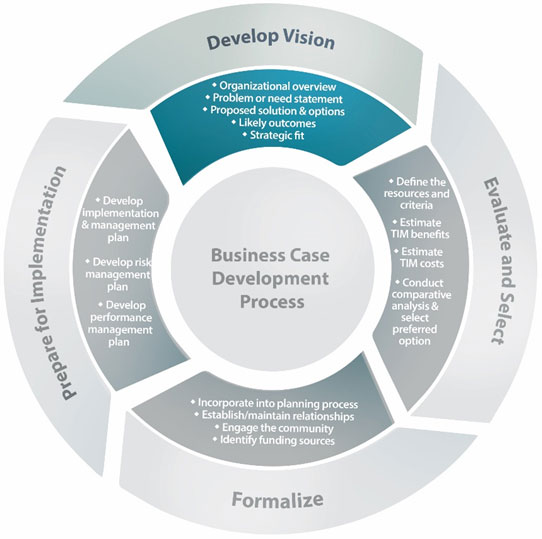
slide notes
The vision should articulate how the initiative affects the future – in essence, "how will solving this problem change the future?"
By describing the business need and desired outcomes, a well-developed vision will help to establish the case for change and the need for investment.
The vision consists of the key elements listed here. Each of the key elements is described in the following slides.
slide 10
Provide Organizational Overview
- An organizational overview will include:
- Organizational structure
- Business objectives
- Current activities, services, audiences, and stakeholders
slide notes
The organizational overview should include a high-level description of the organizational structure, as well as information on the agency and TIM missions, strategic vision, goals, and business objectives. Other information within the organizational overview might include current activities and services, audience, and key stakeholders.
slide 11
State the Need and Drivers for Change
- Develop a brief, compelling, service-oriented problem or needs statement:
- Presented in the context of the current environment
- No more than 1-2 sentences
- Identify what has triggered the investment proposal
slide notes
Three approaches to the problem or need statement include:
- Stating what is being proposed and why.
- Describing the current situation and specific adverse performance – for example, problems, difficulties, and inadequacies
- Presenting how the world is today and how it will look after the proposed change is implemented.
The problem statement should clearly and succinctly describe the problem from the perspective of the public, stakeholders, and the broader agency.
Drivers for change can be internal and/or external.
- Internal drivers include agency goals, champions, and access to resources
- External drivers include major events, political priorities, and performance
slide 12
Propose Solution and Likely Outcomes
- Introduce the proposed solution and options considered
- Articulate the investment boundaries for each option
- Present the likely business outcomes as expected benefits (e.g. mobility, safety)
slide notes
In addition it is important to demonstrate how the proposed solution aligns with and contributes to the overall strategic goals of the organization.
The scope of the business case clarifies what is to be included or excluded from each option. If the business case is being developed to maintain the existing TIM program and funding levels, then two alternatives may suffice:
- The base alternative of the continued expenditure of capital resources consistent with the past.
- The "No TIM" alternative that would eliminate funding and allow the dissolution of the TIM program.
If the business case is being developed for a significant new TIM capability, there may be multiple alternatives.
Outcomes answer the question, "What are we trying to achieve?" Potential outcomes are the reason for undertaking a project and are therefore critical to a successful business case.
slide 13
EVALUATE AND SELECT
This phase includes the following steps:
- Develop evaluation criteria
- Estimate benefits and costs
- Conduct comparative analysis
- Recommend one preferred alternative
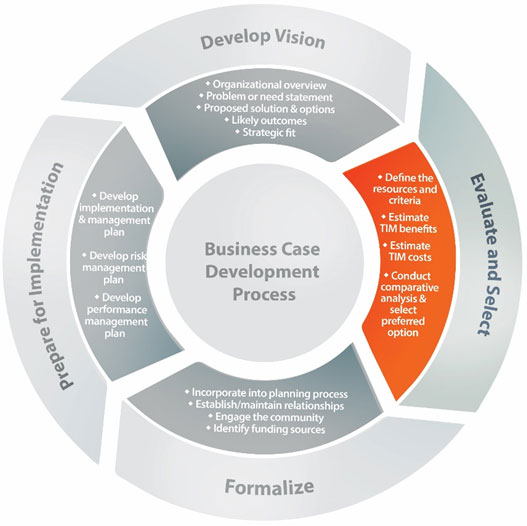
slide notes
Beyond a common basis for analysis, evaluation criteria are needed to compare investment options. These criteria, along with the benefit-cost ratio (BCR), should be used to select the preferred alternative. The criteria development may be a multi-level process or completed in a single step, may be quantitative (e.g. potential to reduce incident duration by 5 minutes) or qualitative (e.g. high, medium, or low alignment with stakeholder need).
The criteria may provide added weight to certain considerations. For example, if the legislative and agency focus is on mobility, then alternatives with a more significant mobility benefit may be higher valued compared to an alternative that provides greater agency efficiency.
slide 14
Develop Evaluation Criteria
- Ensure that the alternatives have a common basis for analysis (e.g., lifecycle vs. single-year)
- Define a common framework for comparison that includes cost, schedule, risk, and expertise for each alternative
- Finalize a consistent set of evaluation criteria:
- Criteria should be strategically and contextually relevant to both the organization and relevant stakeholders
slide notes
Beyond a common basis for analysis, evaluation criteria are needed to compare investment options. These criteria, along with the benefit-cost ratio (BCR), should be used to select the preferred alternative. The criteria development may be a multi-level process or completed in a single step, may be quantitative (e.g. potential to reduce incident duration by 5 minutes) or qualitative (e.g. high, medium, or low alignment with stakeholder need).
The criteria may provide added weight to certain considerations. For example, if the legislative and agency focus is on mobility, then alternatives with a more significant mobility benefit may be higher valued compared to an alternative that provides greater agency efficiency.
slide 15
Estimate TIM Benefits
- TIM benefits fall into five categories: mobility, safety, efficiency, environmental, and traveler satisfaction
- The quantification of TIM benefits (expected or observed) is a key activity in developing the business case:
- Select estimation methods and tools based on the scope of the proposed investment, data availability, time and expertise
- The monetization of TIM benefits is also a key component of the business case
slide notes
TIM benefits are realized by the transportation organization, partner organizations, user communities, and the public at large. When estimating the benefits associated with TIM investments, a wide perspective of stakeholders should be captured through quantitative, qualitative, or monetized benefits. Quantitative TIM benefits are derived from activities that promote quicker restoration of roadway capacity, more efficient deployment of resources in the response to incidents, and diversion of demand away from incidents.
While the benefits from TIM are significant and clear to many, quantification and monetization of the benefits of TIM activities involve more complex analyses and require data on TIM performance, traffic operations, and enterprise-level programmatic performance and resource data. Core data needs for TIM benefits analysis include incident and incident response statistics such as frequency, duration, time of occurrence, number of lanes affected, and demand prior to incident.
Monetization is the process of calculating financial values based on the quantified benefits/predicted benefits of TIM activities. In many cases monetization is as simple as multiplying the quantified benefit by a numerical dollar value.
slide 16
Estimate TIM Costs
- Cost estimation is typically agency specific
- Common cost delineation includes two areas:
- Capital investment costs
- Recurring operations and maintenance (O&M) costs
- Tracking O&M costs can be complex, because resources are often shared between program areas
- Always present cost estimates of options in the same constant base year
slide notes
Depending on the vision and scope, the establishment or expansion of a TIM program can range from very little initial investments or direct costs to large initial investments or direct costs associated with the acquisition and deployment of equipment and the training and resourcing of personnel.
For most programs, TIM costs are under the umbrella of larger agency operations budgets, which may include traffic management and traveler information systems. It can be challenging to isolate how much money is spent on TIM personnel and equipment agency-wide, which impedes the ability to make a solid argument for increasing allocations.
TIM program and strategy costs should be tracked so that they are easily accessible and used in analyses.
slide 17
Conduct Comparative Analysis
- The benefit-cost ratio (BCR) is the most essential step to the comparative analysis
- Because some benefits are difficult to quantify, also develop and include a summary of all benefits
- Demonstrate the analytics and strategic basis for selecting the preferred option
- Further clarify the recommended preferred option, including an approach to implementation
slide notes
When making the business case for TIM expenditures, the BCR will typically underestimate the value of a program given that costs can be accurately captured, but certain types of benefits are difficult to monetize (e.g. safety and reliability benefits). Therefore, it is essential that the summary of the business case include not only the BCR, but also the quantitative benefits, qualitative benefits, and the strategic fit.
Within the business case report and briefing, agencies should be sure to provide a comparative summary of all options and demonstrate the analytics and strategic basis for the preferred option compared to all others. The evaluation criteria outlined in the analysis should also be reused, along with new information discovered during the detailed analysis.
The recommended option should be clarified, including the approach to implement with sufficient detail to instill confidence that the proposed investment has been appropriately considered, and that the presented estimates are within an acceptable degree of accuracy.
slide 18
FORMALIZE
Key activities in this phase include:
- Incorporate TIM into the planning process
- Establish and maintain relationships with partners
- Involve and engage the community
- Work to improve the organization's overall TIM processes and capabilities
- Identify funding sources
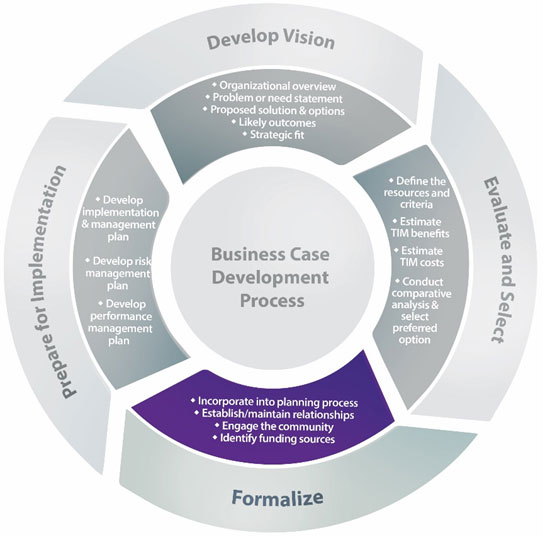
slide notes
Formalization involves activities that help to integrate TIM within and across organizations, prepare the TIM program or strategies for institutionalization, and identify potential funding sources for the program – in essence, activities that help to establish the TIM program as part of the fabric of the agency or agencies
The Formalize phase consists of the activities listed here. Each of these activities is described in the following slides
slide 19
TIM in the Planning Process
- Develop a focused TIM strategic plan
- Add TIM as an emphasis area or key strategy in planning documents such as:
- Strategic Highway Safety Plan (SHSP)
- Statewide Transportation Improvement Program (STIP)
- Long range plan (LRP)
- Include TIM as a point of discussion when planning construction and maintenance projects
slide notes
Including TIM in the transportation planning process is a good business practice for DOTs, their planning counterparts, and the regional TIM partners. The business case report in and of itself is not sufficient to make the business case. TIM programs need visibility, support, and funding opportunities; incorporating TIM into the planning process can help. In fact, in some cases, a program must be included in the planning process in order to access certain funding mechanisms.
Incorporating TIM into strategic planning helps to strengthen the support and funding for a TIM program, as well as make it more widely known as an important, lower-cost strategy proven to improve safety and mobility.
Other planning documents to consider include:
- Transportation Improvement Program (TIP)
- Congestion Management Plan
- Regional Transportation Safety Plan
- Metropolitan Transportation Plan
slide 20
Strengthen Stakeholder Relationships
- TIM partnerships and relationships demonstrate commitment and program strength to decision-makers
- Formalized TIM partnerships foster efficient data sharing, benefiting the overall TIM program
- Public involvement and engagement promotes broader acceptance of and support for TIM initiatives
slide notes
The development of a business case for TIM should be a joint effort. Getting partners onboard and involved will ultimately result in a stronger business case.
Strategies to involve and engage the community include public awareness programs, public information and outreach campaigns, public education, and training efforts.
slide 21
Funding Sources
- Federal-aid programs, such as the National Highway System (NHS) and Congestion Mitigation and Air Quality (CMAQ) Programs, are an important TIM funding source
- New potential funding sources may be identified under the MAP-21 Fixing America's Surface Transportation (FAST) Act
- Grants, as well as local and State funding, are also used for TIM programs and strategies:
- Grants.gov is the main source of Federal grant information
slide notes
In order to establish, maintain, and improve TIM programs, adequate and ongoing resources to support operations are needed. Program administrators must not only understand the funding process at the Federal, State, and local levels, but they must also be able to identify specific sources of monetary support appropriate for TIM and successfully compete for these funds.
It can be a significant challenge to obtain and maintain funding for TIM. To overcome this challenge, the benefits of the existing TIM investments or efforts must be marketed internally and externally.
(last bullet)
Traditional funding is not the only source that should be considered for funding TIM. Agencies also make use of grants as well as local and State funding, often in innovate ways. While grants are often useful to jump-start multi-agency efforts to achieve interoperability, grants alone cannot usually sustain a program for an extended period of time. Therefore, any initial achievements made through grant funding must be sustained using agency funds.
A major shift of mindset is needed from one-time funding for capital projects to ongoing funding for critical operations.
slide 22
Capability Maturity Framework
- The TIM Capability Maturity Framework (CMF) complements and intersects the business case:
- Advancing through the CMF readies a TIM program to articulate a strong business case
- In developing the TIM business case, agencies give attention to key concepts within the CMF
- Expected benefits of using the CMF tool for TIM include:
- Jumpstarting the program-level improvement process
- Providing justification for program support and direction
- Improving consistency and collaboration among agencies and between jurisdictions
- Continuing program improvement
slide notes
The TIM CMF is available as a web-based tool on the FHWA Office of Operation's Web site and has been integrated with FHWA's annual TIM SA. The CMF tool enables users to conduct the self-assessment, record the discussion and consensus building around each question, and identify and prioritize actions.
slide 23
PREPARE FOR IMPLEMENTATION
This phase includes the following steps:
- Develop an implementation plan
- Develop a risk management plan
- Develop a performance management plan
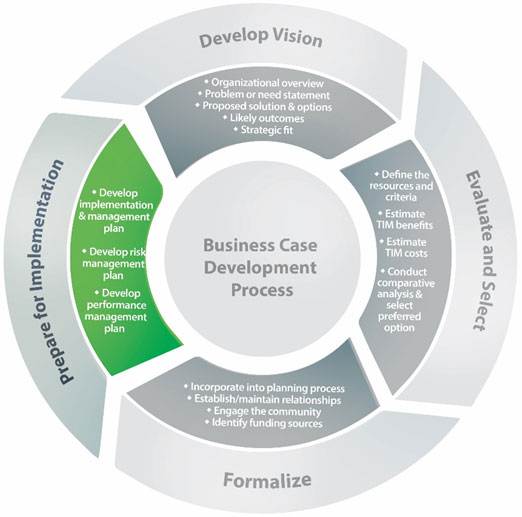
slide notes
Preparing the proposed TIM investment for successful implementation is the final stage in the business case development process. This stage lays out the actions that an organization(s) will need to undertake to implement and manage the approved program, including the development of:
- An implementation plan
- A risk management plan
- A performance management plan
slide 24
Readying for Implementation
- Best practices in program management recommend the development of a number of "plans" to ensure a successful and efficient implementation. Three such plans include:
- Implementation Management Plan – illustrates in detail the critical steps in starting and developing the project
- Risk Management Plan – identifies risks, estimates impacts, and defines responses to issues if they arise
- Performance Management Plan – addresses how success will be measured and demonstrates transparency and accountability
slide notes
The development of an implementation and management plan demonstrates a commitment to the execution and management of the program. The explicit articulation of the implementation and management plan instills confidence that the recommended investment will be well managed across the project or program lifecycle.
Risk management is critical to the success of any project and must be developed during the planning stages of the project management process. A risk management plan should provide a summary of the risks associated with the project/program, demonstrate that the organization has a function in place to manage the risks, and describe how the risks will be monitored and managed.
Developing a performance management plan will demonstrate transparency and accountability for the project. The performance management plan addresses how the success of the proposed investment will be measured.
Other plans that may be warranted would be based on the scope and complexity of the project and stakeholder environment.
slide 25
Final Report
The final report Making the Business Case for Traffic Incident Management will be posted on the FHWA Office of Operations Web page.
slide notes
The final report Making the Business Case for Traffic Incident Management provides more details on all of the information covered in this presentation. The report will be posted on the FHWA Office of Operations Web page.
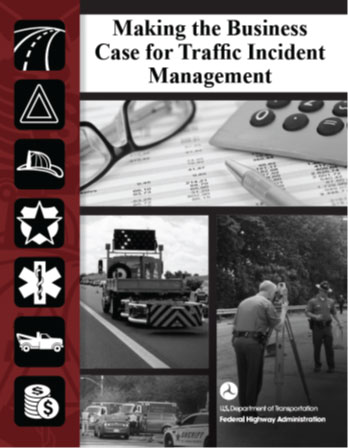
slide 26
Available Resources
slide notes
In addition to this report, a number of resources are available to assist agencies as they seek to collect the necessary data, conduct the appropriate analyses, and develop the information needed to make a strong business case for TIM. These resources are referenced throughout the report and can provide additional information to specific aspects of the business case development process.
A few of the particularly relevant resources are listed here.
slide 27
Questions/Discussion
For more information, please contact:
Paul Jodoin
Office of Operations, Federal Highway Administration
U.S. Department of Transportation
202/366-5465
Paul.Jodoin@dot.gov